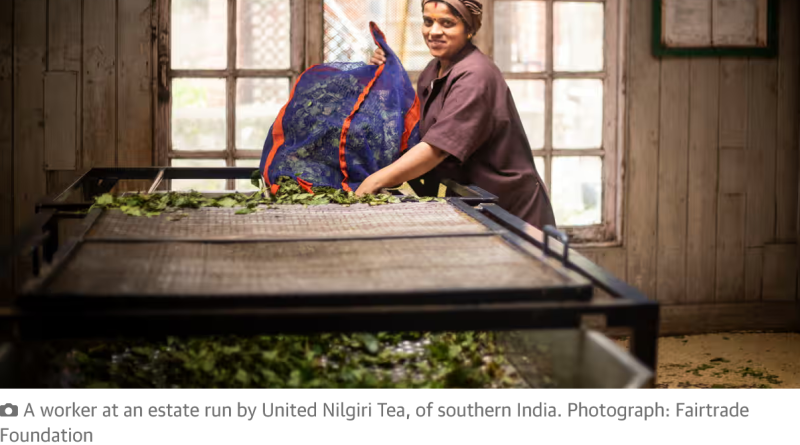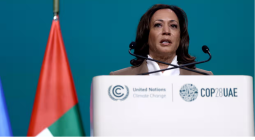Sick leaves: tea growers’ climate misery leads to jump in UK prices

Tea is a British institution and 100m cups will be drunk today, but experts are warning that our beloved brew could get pricier as extreme weather causes misery for growers in India and Kenya.
Last week’s official cost of living update put food inflation at 1.5%, but a breakdown of price moves showed a box of 80 teabags now costs £2.65, a rise of 18p, or 7%, on a year ago.
A recent analysis in food industry bible The Grocer pointed to bigger hikes, with the price of branded and own-label “everyday” teabags in supermarkets up by as much as 30%.
One factor already at play is supply chain problems resulting from Houthi attacks on vessels in the Red Sea.
But further price increases could be on the horizon for what has always been an affordable drink. Harvests in Kenya and India, which together supply half the UK’s tea, have in recent months been disrupted by heatwave, drought and flooding.
“I’ve just been in India where the north-east is having a drought and the south is having too much rain and farmers are talking about productivity down 40%,” says Anna Mann, associate director for responsible business at Fairtrade Foundation.
“The price of tea hasn’t changed in a decade. We’re looking at one of the first times when there might be shortages and it will have to shift.”
In May, tea production in India was down 30% on 2023 to what was the lowest haul for the month in over a decade. As a result, in the last week of June, the country’s average tea price topped £2 a kg, almost 20% up on a year ago, according to India Tea Board data.
Across India growers are battling stagnant or falling yields due to the climate crisis, says Shilajit Roy Choudhury, vice-president of the United Nilgiri Tea Estates company.
“I’ve been in the plantation industry for 35 years now and see the change,” he says. “I would love, every day, to have sun in the morning and rain in the afternoon. Historically that was the case. It is not any more.”
The company is based in Tamil Nadu in southern India and Choudhury says it would normally get spring showers in February and March and a major crop in April and May. This year, he says, “our rains are already a month and a half late”.
The Fairtrade supplier has invested in better agricultural and harvesting practices, he says, but is having to adapt. “We are 6,500-7,000ft above sea level and in May had temperatures touching 30C which is very unusual.”
Tea is unusual among agricultural commodities in that, unlike coffee and cocoa, there is no futures market. This means prices are determined by supply and demand with about 70% of the world’s tea traded through auctions.
Producers receive different prices for higher and lower grades. African black teas tend to be lower grade, due to the varieties and production techniques, and are more likely to end up in our teabags.
Intermediaries can take a large slice of the money paid by the factory for small-scale growers’ tea, meaning they earn a fraction of the amount it fetches in shops here, according to the Fairtrade Foundation.
Climate change is threatening tea-growing regions of east Africa with deeper and longer dry seasons, although this year unusually heavy rainfall has been an issue.
“I’ve been tea farming for 26 years and there have been some very big changes,” says Geoffrey Mitei, who grows tea on one acre in Kericho County, Kenya.
He is part of a Fairtrade producer organisation that had to buy in water for processing tea in its factory after the floods affected its supply, resulting in increased operational costs.
More normally the concern is a lack of rain. “If there is a drought in the early part of the year our tea production goes down,” says Mitei, who adds that when there is an oversupply “we have a challenge with fluctuating prices”.
The tea farmer’s cause has not been helped by changing tastes: the rise of coffee culture as well as younger consumers switching to herbal infusions and kombucha.
When Unilever put its tea business up for sale four years ago the then boss pointed to falling demand for so-called “builder’s tea”. Its drinkers were “getting older and consuming less and starting to fall over”.
Andrew Thompson, professor of molecular plant science and head of soil, agri-food and biosciences at Cranfield University, says: “Coffee has grown and tea hasn’t, and when you go into a high street coffee shop you’re paying twice as much for coffee as for tea.
“It’s around the culture and what people are willing to pay … so the price has remained a bit static. There is this slight problem of oversupply but I don’t think that’s going to last that long.”
“If you look forward at effects of climate change, then you get downwards pressure on east African production mainly because of drought but occasionally floods,” says Thompson, who is involved in a Kenyan project with Lipton Teas and Infusions to breed drought-resistant varieties of tea.
This is making fair prices even more urgent as without the ability to invest in their farms, producers cannot hope to mitigate the impact of global heating, says Mann.
“Shoppers don’t realise,” she says. “They’re having a cup of tea, they love it, but in a year or two from now this could have massive knock-on effect on where tea comes from, what it tastes like and the price we pay. It’s happened in cocoa. The worst happened and the price jumps were absolutely phenomenal.”





